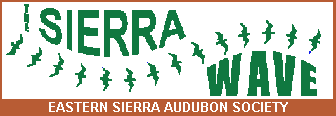
Eastern Sierra Audubon
Sierra Wave Newsletter
Volume 30, Number 5
May-June, 2012
Contents
- Events:
- Features:
- Reports:
- Business
Events
You Are Invited
To the Annual
Audubon June Picnic!
Where: Bishop City Park, Bishop, at the pavilion in the back across from the Senior Center.
When: June 7th, Thursday, 6:00 pm
Audubon members and friends are invited to attend our annual picnic on Thursday, June 7th, starting at 6 pm at the City Park in Bishop. We look forward to another fun social event with great conversation and lots of good food. We ask each participant to bring an ample dish and beverage to share, your own place setting and a folding chair, if desired. Invite a friend or neighbor to enjoy a lovely picnic in the park. We can enjoy birding (and bat-watching) before and after the picnic!
This is the chapter's annual meeting at which the election of the Eastern Sierra Audubon officers and members of the board of directors takes place. We will hold the election after dinner, but we need candidates! If you would like to nominate a candidate or be considered as a candidate, please come to the meeting or contact a board member in advance of the meeting. If you know of someone that might be interested, bring them!
We STILL need a new Vice President, to learn the ropes with our current president and be ready to step into that position when he steps down, and we desperately need a Program Chair, to help us find and organize our evening programs (only 4 a year, plus this picnic, now). We are also losing our Treasurer and possibly our Membership Chair! Anyone is welcome to become a General Board Member to meet and help plan the activities of the chapter, oversee finances, guide the chapter in conservation matters, participate on behalf of the chapter at events and programs and share their ideas and enthusiasm with the other members of the board. It's a great group of folks to work with!
Please contact any member of the Board if you are interested in filling any of these positions, including general board member at-large. You may arrive as early as 5pm if you'd like to help set up.
Please Bring:
- a dish for 6-8 people to share,
- your own table setting,
- what you want to drink,
- lawn chairs if you don’t want to sit at the picnic table
- A friend who might be interested in Audubon!
For more information call Roberta at 760-872-7846. Everyone is welcome to attend all programs!
Back to Top
Upcoming ESAS Field Trips
May 12, Saturday, 9-10:30am: Spring Bird Migration to Mammoth Lakes
Leader: Jane Kenyon (looking for a co-leader - anyone interested?)
New to birding? Give it a try on International Migratory Bird Day! Walk along Mammoth Creek and discover what migratory songbirds have arrived this Spring as we listen and look for songbirds along the creek corridor. Binoculars and a bird book will be helpful to identify what we see.
Walk will be approx 1 mile round trip.
Meet at Mammoth Creek Park on Old Mammoth Rd, 2 blocks south of Vons.
Info: Jane 934-0372
Back to Top
June 9, Saturday, 9am: Middle Fork Bishop Creek Birding
Leader: Larry Nahm
Breeding should be well underway along the creek below Lake Sabrina. Swallows, Mountain Bluebirds, pewees, sapsuckers, warblers, and hummers use a variety of vegetation in the area. We'll walk easy paths and roads along both sides of the water, making a loop. Meet at 8:15 a.m. in the parking lot just west of Joseph's Market in Bishop to carpool, or at the junction of the Lake Sabrina/North Lake Road above Aspendell at 9:00 a.m. The morning outing may conclude with a stop at Four Jeffrey Campground on the South Fork. Bring binoculars, snacks, liquids, warm clothes. For more information contact leader Larry Nahm at 872-4125.
Back to Top
July 21, Saturday: Devils Postpile National Monument
A naturalist will take us on a walk in this area of unusual beauty. Please check back on our Field Trips page for details.
Back to Top
Back to Top
Owens Lake Fall Big Day: August 21st
Our Fall Big Day is scheduled for Tuesday, August 21st. The data that we gather will be used in the management of habitat and birds by LADWP, Audubon, State Lands Commission and CA DFG. Your commitment to Owens Lake in real terms is invaluable.
Meet at 7:00 AM at the Diaz Lake parking lot. We will have a brief introduction and then get out on the lake in small groups. Car pooling is helpful, although not required. Roads are unpaved, but good. Bring a safety vest if you have one. We will provide them as well. Check the weather and dust cams to know what to expect closer to the date.
For more information and to sign up, contact Mike Prather at 760-876-5807 or mprather@lonepinetv.com. Be sure to look for and become a friend of Owens Lake on Facebook for updates and great photos!
Read more on our Owens Lake page
Back to Top
Eleventh Annual Mono Basin Bird Chautauqua, June 15-17, 2012

Wilson's Phalaropes, from the Chautauqua website, Photo by Marie Read
Bird Chautauqua Registration Now Open
Registration for the Eleventh Annual Mono Basin Bird Chautauqua got off to an enthusiastic start on April 15th with over 200 people registering within the first 24 hours. If you’ve forgotten to register do not despair, half of the eighty events offered still have space available.
Based out of Lee Vining, this celebrated event is among the best of the nature festivals blending science, art, music, and great food into one 3-day event. Subjects offered, in addition to birds, will include flowers and plants, butterflies, dragonflies, mammals, geology, nature awareness, photography, storytelling, and art. Several kids' events are also being offered.
The picnic, concert, and bird calling contest at the Mono Lake County Park is always a popular way to end the weekend’s festivities. This year the Adams Burns Band will be providing the music. The band is a local’s favorite, drawing big crowds out of the back country each time they play at the Mobil in Lee Vining. As always, the picnic and concert is open to the general public. Lee Vining High School will be providing lunch at the picnic again as a fundraiser.
Complete program information is posted on the Chautauqua web site. For more information or to register, please visit: www.birdchautauqua.org.
Dave Marquart
Back to Top
Features
President’s Message
“So, are you saying, that these grebes mean
nothing to us?”
— Owens Lake Bird Count, April 25, 2012
Four of us are studying two maps trying to determine where we are. It isn’t that we are lost in a traditional sense, we just need to decide what “counting cell” is off to our left and whether we have already tallied the large raft of grebes in our count. When I contemplate any future outdoor activity, I always picture it taking place on a warm, clear, sunny day. This is not such a day. It is not cold, but the famous Owens Valley winds are with us, the sky is overcast and what look like precipitation clouds are crawling over the Sierra crest. Still, it seems like a perfect day to be on Owens Lake. The surreal aspects of the landscape with its alkali surfaces, thin sheets of water and maze of piping and irrigation technology are enhanced by the dramatic sky and constant wind.

Owens Lake Plumbing at work - "filling the tub" - photo by Michael Prather
There were a lot of highlights from this day. The evening before, our waitress, a former Lone Pine school student told Mike Prather not to lean back in his chair and sit up straight. It may take a long time but pay back is always a possibility. A lone Osprey flew above the birders gathered at Diaz Lake to head out for the day. It was humbling to be a part of this group of talented and energetic people and share their dedication to increasing our knowledge of avian use at the lakebed. It was gratifying to see all of the white DWP trucks among the group, giving testimony to the partnership which is emerging between DWP and ESAS as we go forward to insure that bird habitat is maintained at Owens Lake.
We saw a lot of birds. We told bird stories, bird jokes and made terrible bird puns as we hopped in and out of the car. A flight of pelicans in a shaft of rare sunshine will not soon be forgotten. There is a special sort of friendship which is expressed and experienced in doing something like this. A big thank you goes to Mike Prather and Debbie House for organizing this count and shepherding us through our days and tasks and to Mike and Nancy for providing snacks, drinks and a place for fellowship at the end of the day.
The bird count was just one part of a big week for me. It started with a day at the Lower Owens River doing docent work for the ESICE watershed program. We were at the Manzanar Reward Road and the changes to the river and riparian areas are noticeable. There were many birds and even though they were not the subject of the field work experience for the 7th graders, they still had questions about the Marsh Wrens, Downy Woodpecker and Loggerhead Shrike which we saw and heard next to the river. Movement and color are so captivating. One really hopes that something will ignite that spark in one or more of these young people which lead them to a greater respect and love for the natural world.
April 22nd was the second “Wild at Home” program, at which ESAS, along with the Eastern Sierra Land Trust, California Master Gardeners, Eastern Sierra Wildlife Care and Chalfant Big Trees Nursery, presented a workshop aimed at helping people make their home landscaping more friendly to wildlife. Although attendance was small, the conversation was lively, the presentations informative and interesting and we were entertained by a group of finches who were feeding and using the birdbath at the Land Trust’s garden.
Tuesday was spent with a meeting of the Habitat Work Group, which is working on reviewing aspects of the Owens Lake Master Plan. It is been a real pleasure to work with the members of this group who come from disparate interests which have often butted heads in the past. From the beginning of these meetings more than a year and a half ago, the group has put aside or moved past previously divisive issues and concentrated at finding solutions to questions posed by the plan and its potential effects on the Owens Lake habitat. This work has become a core of the Master Plan and I have high hopes that this will become a permanent working group charged with protecting and furthering habitat objectives.
Later that day I had the opportunity to talk with a feature writer and a photographer who are working on a piece about the lake for a future edition of the Audubon magazine. Andrea Jones, from California Audubon, Mike Prather and I were able to take them out on the lake and visit with them about the Master Plan process and the work being done by the stakeholder group to chart a path for the future of the lake. These people have had an opportunity to visit a lot of special places and it was pretty cool to hear them express their interest in what we are trying to accomplish and for the unusual beauty that is Owens Lake. It is easy to get caught up in some of the frustration which goes along with a difficult task such as this Master Plan. It is not until I have a chance to talk with someone unfamiliar with those frustrations that I am able to see that a lot of hard and productive work has gone into the effort and that the product has real potential for lasting value
Last, but definitely not in any way least, were the amazing images presented by Bob Steele at the April membership meeting. The Bob Steele show has become one of the highlights of every program year and his photographs and commentary about the birds of Midway Island lived up to his previous efforts. It must be quite something to be as talented as he is and to capture and then show the magic of birds in flight. I can barely wait until next year’s program.
Just one week, but great examples of Audubon and what it means here in the Eastern Sierra. This organization plays an important role in helping the community understand why birds are important and how making the world a better place for them, improves our lot in life as well. Some of this is done with the community in general, through programs and field trips. Some of this work is hopefully accomplished through meeting with policy makers, not to shout or exchange challenging words, but to work through the tough details and decisions required to protect the future of one of California’s most significant Important Bird Areas.
A big part of it is through dealing with schools and students. To that end, and from a successful bird-a-thon fundraising effort, ESAS was able this year to offer two $500 scholarships to students from Mono and Inyo counties to help them pursue their college studies. This is a wonderful accomplishment, not just for the students, but for our organization. Audubon is about education and the things which it can make possible. We are very hopeful that this can become an annual award and will be sure to remind you all about this when we seek you support in coming bird-a-thon efforts. Thanks to the contributors and birders that made this possible.
Oh, about those grebes... we decided we had previously counted the grebes from another vantage point. That notwithstanding, they have a very special meaning for us as they raft in what was a dead lakebed not so many years ago. May they be able to do so forever.
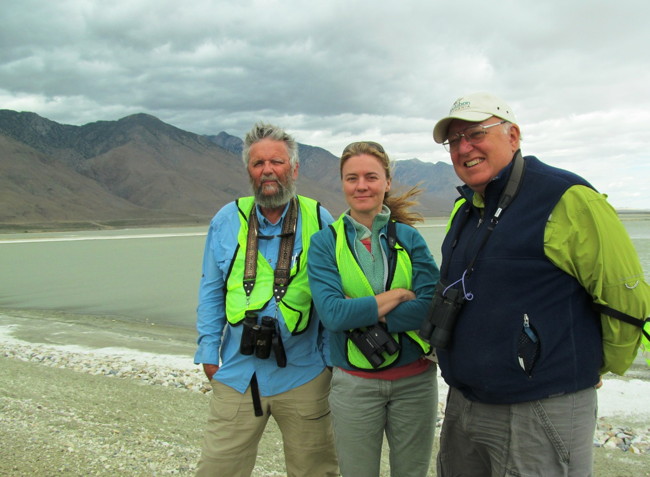
"Three Amigos" - Michael Prather, Andrea Jones, and Pete Pumphrey, out on Owens Lake, photo by Nancy Prather
Pete Pumphrey
Back to Top
Spectacular Avian Event: the American White Pelican in the Eastern Sierra
Spectacular Avian Event: the American White Pelican in the Eastern Sierra
[Click on any photo to see all in a slideshow]
By Tom & Jo Heindel
Many locations have spectacular wildlife observation opportunities and the Eastern Sierra can claim one of them. If one wants an awe inspiring experience with Sandhill Cranes, a winter trip to Bosque del Apache National Wildlife Refuge, New Mexico, will not disappoint. If your taste runs to whales, a pelagic trip in fall or spring out of Monterey, CA will produce several species, many up close and personal. Some exciting wildlife observations involve one mammal, a Mountain Lion or Marten, or one fish, "it was THIS long!", or one bird, a Golden Eagle stooping on a Sage Grouse. But the Eastern Sierra's biannual event, in March and April and again August to October, involves thousands of very large and very graceful birds...the American White Pelican.
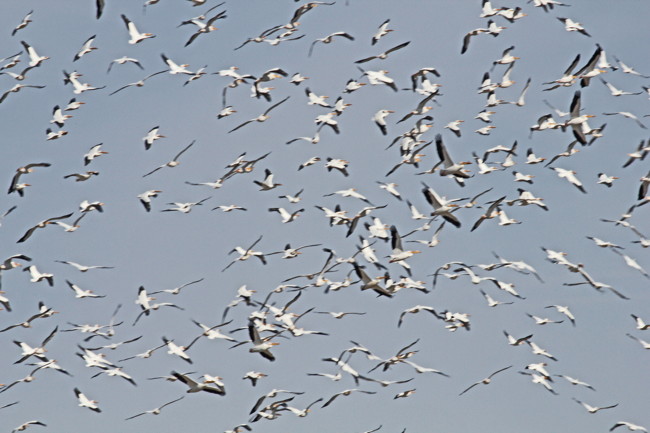
White Pelicans in flight, photo by Tom Heindel
In early April 1998, we were driving south on Hwy 395 towards Big Pine when we noticed oncoming traffic pulling off the highway, en masse, onto the shoulder. We assumed an emergency as people were exploding from their vehicles but then realized that they were pointing into the sky and some were grabbing cameras to take pictures. Quickly we pulled off to see what could make a dozen car owners decide to do the same thing simultaneously. As we looked into the clear blue sky we had a second or two where we saw nothing and then, magically, an apparition of silvery-white dots formed and sharpened to show thousands of white birds with large yellow bills and black wing tips...pelicans. The crowd could be heard claiming that they'd never seen such a beautiful ballet...ohhhhh....so many birds at once...such grace and timing...ahhhhh...how did they not bump into each other...amazing! Too soon the flock of over five thousand birds continued moving to the north to their breeding grounds and disappeared. There was no way to know if these birds would breed as close to us as northeast California or northwest Nevada or were going to continued further north into western Canada.
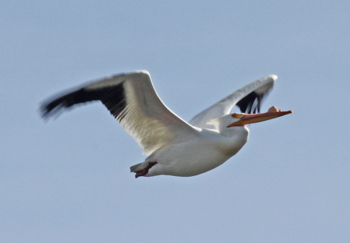
American White Pelican, photo by Tom Heindel
The American White Pelican is among the largest flying birds with a wingspan of 8-9 feet and weighing in at 11-20 pounds or more, with males slightly larger than females. They winter in the southwestern U.S., Gulf States, and Mexico. In March 1987, 40,000 pelicans were recorded at the Salton Sea and Patten, McCaskie, and Unitt (2003:82) estimate that one-third to one-half of the entire population of American White Pelicans spend the winter there with most of the balance of birds in western Mexico and the Gulf Coast of the southeastern U.S.
The Eastern Sierra is a reliable region to view these graceful giants in migration. The many reservoirs and lakes provide resting and eating zones and the mountains provide the thermals necessary for these large birds to get airborne. They are diurnal migrants and often can be seen in the early morning at Tinemaha Reservoir and Crowley Lake. If undisturbed they linger in the morning as they wait for the sun and mountains to work their thermal magic. They exercise their wings, first a few birds, then more, and then almost the whole flock at once. Then one bird is airborne, quickly followed by a small group, then many small groups, and then the entire flock. The sound of thousands of wings straining to lift their heavy bodies is not something one will ever forget.
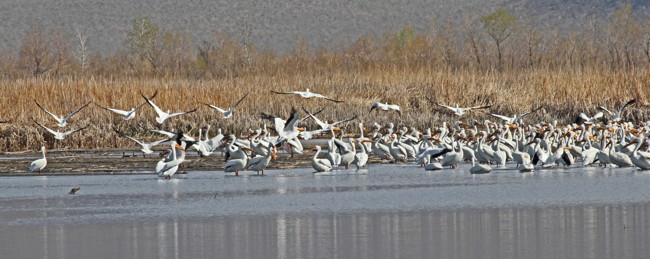
White Pelicans stretching their wings, photo by Tom Heindel
At Tinemaha Reservoir in spring, they move towards the north end and then between 0830-0930 their muscles are warmed and stretched and the thermals are beginning their elevator ride up the mountains. Once the groups become airborne, there is a period when the sky seems filled with chaotic patterns of whirling and swirling subgroups flying directly at other subgroups and then becoming a part of another group. As they soar the thermals generate lift and seemingly without any effort the pelicans begin to gain altitude, the groups coalesce into organized units, V's are formed of 40-80 birds, each riding the bow wave of the one in front of it. After a time, the leader of the V allows another to become the bow to plow through the air creating a smoother path for those that follow and the former leader will choose a spot further back in line to take a well-earned rest, yet maintain his position within his group seemingly without effort. In a surprisingly short time, the uplifting and inspiring performance is over as the birds reach altitude and aim their internal compasses north leaving the observers awe-struck and wishing it has lasted longer...but the pelicans have miles to go before they sleep.

White Pelicans in ever-shifting flight formations, photo by Tom Heindel
With no headwind to hinder progress or tailwind to assist, the average speed a pelican flies is about 35mph. Late afternoon will find the flocks from Tinemaha Reservoir north of Reno, NV. If their breeding home is Anaho Island at Pyramid Lake, their trip is almost completed. If they are inbound to breeding grounds in British Columbia or Alberta, another couple of days may be required.
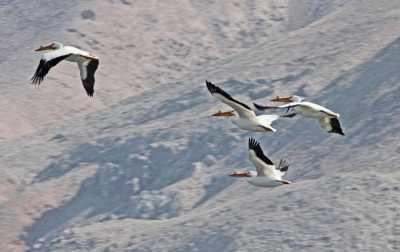
White Pelicans in flight, a closer look, photo by Tom Heindel
Both sexes fly together in these flock although pair formation does not take place until they reach their breeding grounds. Two eggs are laid, although the first to hatch is frequently the only one to survive and incubation lasts about 30 days. American White Pelicans do not breed until they are three years old. In their first year, 41% will not survive and in their second year 16% will perish.
American White Pelicans are often reported in the Eastern Sierra during the summer. These are probably failed breeders or sub-adult birds that are not old enough to breed. As time, our worth enemy, flies by, it will not be long before we see the first Vs returning from the north and in the late afternoon the birds begin breaking out of formation over reservoirs or lakes to settle down for the night. In the morning they begin the ritual to get their bodies and wings ready for another day of flying. Before we know it they are gone, taking with them a magnificent avian performance, and leaving behind memories and stories of what once was.

White Pelican at Benton Hot Springs, with Yellow-headed Blackbird doing a "photobomb" flyby,
Photo by Aaron Johnson
Back to Top
The Long and Short of it
How to tell Long and Short-eared Owls apart in flight
Photos taken in Hammil Valley, Mono County
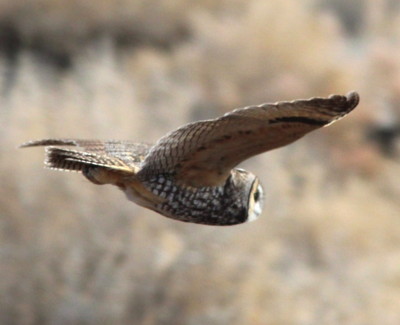
Long-eared Owl in flight, showing underwing coverts
Photo by Debby Parker
I’ve always had a hard time telling a Long-eared (LEOW) from a Short-eared Owl (SEOW) especially if they fly by at dusk in the fields behind our house. Field guides mention the type of habitat they are usually found in or their flight style. Supposedly, the SEOW has a slower meandering moth-like flight and some field guides note the LEOW has a stiffer wing beat. If all I see is their flight style, is that enough to prove which owl it is? If one is perched, most of us can tell which owl we’re looking at. On a perched bird, maybe near its nest, the long ear tufts of a Long-eared Owl could easily be separated from a Great Horned Owl that has shorter tufts that are spread wider apart on the head. But on a Long-eared Owl, seeing these ear-tufts in flight is next to impossible as they disappear, flattening out, making the head round and smooth, and it is the same for the Short-eared Owl, making the ear-tufts an unusable mark in flight. Some field guides note that Short-eared Owls will sit on fence posts in a field and that’s how you can identify them. Look for a slightly fatter head and no ear tufts. But can we be 100% sure on a very distant bird which one we are looking at if we can’t see more of it than its perching style?
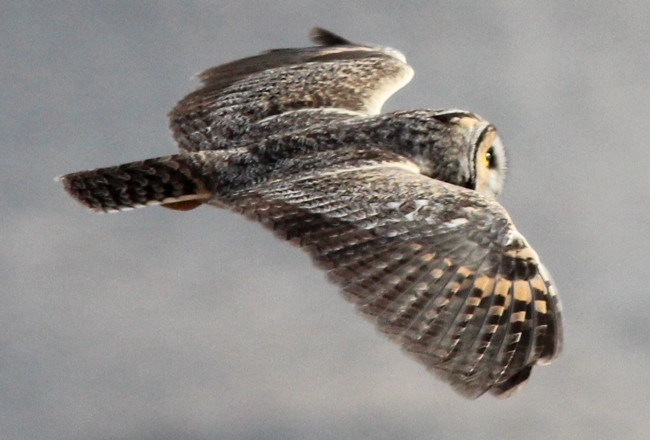
Long-eared Owl in flight, showing its orange facial disk
Photo by Debby Parker
With these perplexities, I hope the following discussion will help our local birders be able to tell these two owl species, Long-eared and Short-eared Owls, apart, if in fact we are fortunate enough to see one in flight.
Above are two Long-eared Owl photos and below are two Short-eared Owl photos (followed by two photos for you to test your skills with) showing these species to be similar in size and plumage. No wonder we struggle with our fast short looks. One of the first marks we see in the field guides that both owls have is a buffy wrist-patch seen on the topside of the wing. These buffy patches are slightly different on each owl but I find them not super useful in telling me which of these two owls I’m looking at, because both owls have them. These marks would be useful in telling us we don’t have a Barn or Great Horned Owl. On a fast moving bird, do we have time to see the slight differences in this mark to differentiate between the LEOW and SEOW? Probably not. Let’s move onto other more useful marks which I find a big help with this problem.
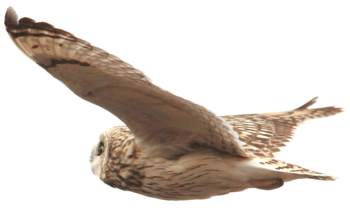
Short-eared Owl in flight, showing pale underside
Photo by Debby Parker
The first mark I find very useful and obvious is the streaking on the underside of the owl in flight. The underside includes the chin, breast, belly and vent area. As we can see in the photos above, the Long-eared Owl shows a noticeably darker underside with a strong “cross-hatched” pattern covering the underside from the neck through to the belly which is darker than the Short-eared Owl. Looking at the Short-eared Owl photos we see a very different underside, much paler with fine single lines of streaking extending from the neck area through the breast and into the belly which appears mostly pure snow-white. While the neck (area surrounding the facial disc) is slightly darker on the SEOW it is not as dark as seen on the photos of the LEOW.
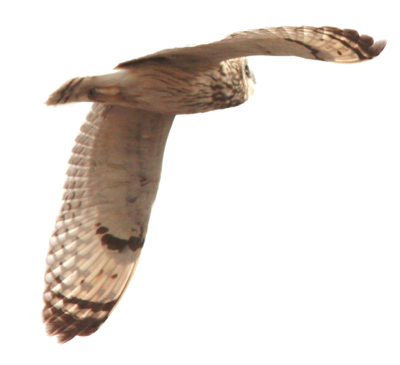
Short-eared Owl in flight, showing underwing coverts
Photo by Debby Parker
The next mark which should help us to tell these two apart in fast flight is the color and pattern of the underside of the wing. Let’s start with the Long-eared Owl again, in the first photo above with the owl raising its wing high we clearly see orangish underwing coverts. Coverts are the fine short feathers that cover the leading edge of the underwing before the longer flight feathers of the primaries and secondaries. Looking at the Short-eared Owl’s underwing and coverts, they are nearly pure white, not orange as in Long-eared Owl. You can catch a look as the owl raises its wing in flight. Looking at more details of the underwing both birds are showing a black carpal patch in the “wrist” area. Once again, both owls have this so it doesn’t really help us to tell these two apart. But looking toward the wingtip below the patch, we can see that these owls are distinctly different. Once again, the Long-eared Owl is darker toward the wingtip of the underwing with a multitude of dark “bars” paralleling across the wingtip (more than four) until they coalesce into a dark patch at the tip. But on the Short-eared Owl, the tip of the underwing below the black carpal mark is much paler with fewer parallel “bars” crossing the wing and a much smaller area of dark toward the wingtip. See how pale the underwing is of the Short-eared Owl compared to the Long-eared Owl?

Look at the barring on the tail.
Would you call this a Long-eared Owl or Short-eared Owl?
Photo by Debby Parker
The next mark to note is simply the color of the facial disc. The Long-eared Owl shows obvious orange in the facial disc and the Short-eared Owl has a whitish disc with black immediately surrounding the eyes. Very different faces.
Our last mark is the barred-pattern on the tail, both upper-side and under-side. Starting with Long-eared Owl again, their tails are barred differently than Short-eared Owls. Long-eared Owls have darker barring and finer parallel bars from tail-base to tail-tip. Short-eared has fewer horizontal bars and paler tail with pale at the base of tail, which really adds to the paleness of their tail. See the photo of SEOW and how you can count the parallel bars. Sibley (2000) in his field guide notes that SEOW have a pale uppertail covert which is different from the LEOW.
I hope these marks will help you to see your owl in more detail as it “swooshes” by on a early morning or late day walk, and while it might take a few times to apply these marks to the owls, I’m sure they will help you see more clearly these fellow travelers we live with.
By Debby Parker
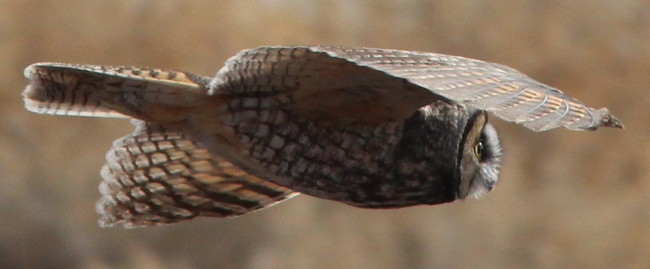
Quick - Which Owl is This?
Photo by Debby Parker
Back to Top
Wildlife Rehabilitation: What Is It And Why Do We Do It??
Wildlife rehabilitation is suturing the throat and crop of a Red-tailed Hawk torn open by barbed wire. It is providing emergency treatment for a White-headed Woodpecker hit by a car and bathing a Pied-billed Grebe in distilled water to remove feather contaminants from the highway to restore water-proofing for release. Wildlife rehabilitation is raising a fuzzy “brancher” Great Horned Owl whose nest collapsed and sibling was killed. It will take weeks of care while the youngster grows in his flight feathers, develops flight skills, and learns to hunt and kill live prey.

Fuzzy "Brancher" Great Horned Owlet at Eastern Sierra Wildlife Care Center
Wildlife rehabilitation includes volunteers paddling two kayaks across Tinnemaha to rescue a White Pelican with a badly injured wing, cutting a Striped Skunk’s head free from a small hole in a dumpster floor, and wading through a cold, muddy canal to save an injured Great Blue Heron.
And wildlife rehab is also about resolving a situation where Raccoons keep disturbing strips of sod destined to become a lawn. (Solution? Leave the sprinklers on all night for 3-4 nights. Raccoons don’t like showers!) It’s visiting Head Start on the Bishop Resevation and introducing 60 young children to Wildlife Ambassador Spirit—our Red-tailed Hawk—and several native snakes. It’s putting two pre-fledge Hummingbirds into an artificially-constructed nest and hanging it from a tree near the originial nest so infested with mites that the babies jumped out. It’s getting the chance to cheer quietly when the mother Hummingbird shows up almost immediately to feed her babies in their strange new nest.
At Eastern Sierra Wildlife Care, wildlife rehabilitation consists of helping, through care and counseling, close to 800 wild birds, mammals and reptiles each year. It is made up of hundreds of stories and consumes thousands of hours of time and effort until each story finds its ending.
Why do we do it? There are probably as many answers as there are animals that come to ESWC for help. We do it because our community cares: people like the family—mom, dad, grandmother and two kids—anxiously handing us a small box with one tiny, still-naked House Finch they have rescued; the mother and her two daughters who courageously rescued a Golden Eagle (who sadly died later from lead poisoning) from the roadside; the sheriff’s deputies who protected an injured Red-tailed Hawk on (395) until an ESWC volunteer arrived to secure it.
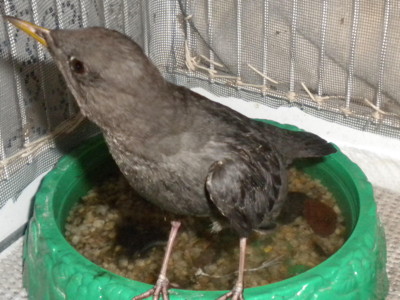
American Dipper recuperating at ESWC
We do it because our hearts lift when a wintering Rough-legged Hawk, who arrived concussed by a speeding car, lifts off into the clear blue sky; we thrill to see an American Dipper, found entangled in fishing line and hooks, freed to dive into the racing waters of an icy mountain stream; and we sigh with relief to see a mother deer reunited with her fawn who was knocked down by a car just 24 hours earlier.
We are rewarded by the awe and fascination in a child’s eyes when he or she see a Red-tailed Hawk up close and personal, by their laughter when Razzle the Raven shakes her feathers or gurgles loudly, by knowing that our wild neighbors will be a little safer because members of our community have learned how to prevent window hits and to keep bird feeders clean to prevent disease.
Spring has most definitely arrived, bringing baby Woodrats, a Coyote pup, a tiny Mallard duckling, baby Great Horned Owls, a baby Mexican Free-tailed Bat, and more. Our seven-hour day will soon become a twelve-hour day; seven days a week ESWC will care for babies and injured adults, rescuing and transporting animals from all parts of Inyo and Mono counties, visiting classrooms, answering phone calls, resolving conflicts between wildlife and people, training new volunteers, preparing for new spring fundraiser, Drive Me Wild Golf Tournament at Bishop CC on June 23. If you find an animal that needs help, want to donate supplies or money or give some of your time, call Eastern Sierra Wildlife Care at 760-872-1487.
By Cindy Kamler

Coyote Pup at Eastern Sierra Wildlife Care Center
Editor's Note: Learn more about Eastern Sierra Wildlife Care and how to volunteer or donate on their website: eswildlifecare.org
Back to Top
Reports
2012 Owens Lake Spring Big Day
On April 25th twenty birders (citizen scientists) joined five LADWP staff to census all of the birds at Owens Lake. The Owens Lake Spring Big Day is an annual cooperative project conducted by Eastern Sierra Audubon and the Los Angeles Department of Water and Power. It gathers data on the number of species and individuals that use Owens Lake each spring for nesting and foraging during migration. A somewhat breezy, but mild day allowed complete coverage of the 40 square mile dust control project and the wetlands around the shoreline of the lake.
The results have not been tallied, but they will be shared as soon as they are available. Some of the birds shared by surveyors were a Sanderling, 20+ Franklin’s Gulls. Bonaparte Gulls, Peregrine Falcon, thousands of California Gulls, American Avocets and ‘peeps’ (our smaller sandpipers), dozens of Snowy Plovers and Semi-palmated Plovers and 10 American White Pelicans. These numbers demonstrate the enormous return of birds to Owens Lake as a result of the Los Angeles Dust Control Project.
Data from the Spring Big Day is used in the management of the birds and their habitat at Owens Lake. The Draft Owens Lake Master Plan calls for the continued protection and even enhancement of wildlife habitat and wetlands. Owens Lake will once again support migrating and nesting birds and it will become an important ecotourism attraction that will help our local economy. The Owens Lake Fall Big Day is August 21st. Contact Mike Prather (mprather@lonepinetv.com) to sign up.
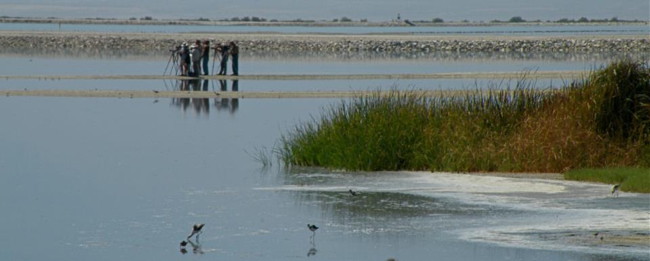
Birders at Owens Lake Big Day, April 25, 2012, photo by Michael Prather
Back to Top
Field Trip Report:
Baker Creek Bench Field Trip, May 5th
On Saturday May 5th, a cold, clear, breezy morning, ten birders gathered for a trip to Baker Creek Bench with leader Jerry Zatorski. The wind diminished enough up in this beautiful riparian habitat to see over 50 species of birds.
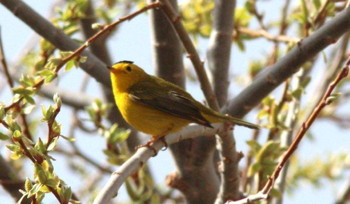
Wilson's Warbler
Photo by Debby Parker
It was an eight warbler day with sightings of Nashville, Wilson's, Yellow-rumped (Audubon's), Townsend's, Orange-crown, Black-throated Gray, and Yellow Warblers, and one noisy Yellow-breasted Chat. Flycatchers were numerous and closely studied throughout the morning. Those seen were Gray, Dusky, Olive-sided, Western Wood-Pewee, Hammond's, Ash-throated and a Black Phoebe. A lovely Cassin's Vireo and a Warbling Vireo were found in the willows with the flycatchers. A Greater Roadrunner crossed our path on the drier alluvial fan just west of the riparian area. We saw two species of hummingbirds, the Black-chinned dipping into the blooming wild iris and Costa's. We also saw three species of sparrows: Chipping, Savannah and Song sparrows.
After lunch, four people continued birding east of Big Pine on a dirt road off of Stewart Lane. We walked on the Owens Valley floor looking at the tops of the saltbush shrubs for La Conte's Thrashers. Two thrashers were first heard and then seen, giving us good views.
Birding Baker Creek Bench in early May is an Eastern Sierra Audubon tradition and not to be missed as we welcome spring to the East side of the Sierras. Thank you Jerry for leading the trip this year.
Kathy Duvall
Back to Top
Appreciation
Owens Lake Receives Grant From Wilson’s Eastside Sports
James and Kay Wilson, owners of Wilson’s Eastside Sports, have generously given a $1500 donation to Audubon-California for the support of the Owens Lake Important Bird Area. The funding originated with Patagonia which provides grants to business partners in support of environmental/community projects in their local area. James and Kay participated in the recent Owens Lake Spring Big Day with Andrea Jones the Audubon-California Important Bird Area director. At the beginning of the Spring Big Day the Wilson’s were given a round of applause and thanks for their long-time support for the Audubon cause!
Michael Prather
Back to Top
Eastern Sierra Audubon Scholarships
Thank you to all students who sent applications for the Eastern Sierra Audubon Society Graduating Senior Scholarship for 2012. We had several good applications which made for a difficult time making a decision. We chose the students whose future work and life goals and past experience most closely reflected the Audubon Mission Statement: “To conserve and restore natural ecosystems, focusing on birds, other wildlife and their habitats, for the benefit of humanity and the earth’s biological diversity.” We chose one Inyo and one Mono County resident for scholarships of $500 each. We will be announcing the recipients and sharing exerpts of their winning essays in the next newsletter (September-October 2012). We plan to offer scholarships annually, so watch for announcements!
Read more about scholarship opportunities here.
Back to Top
Taking Care of Business
Welcome New and Rejoining Members!
Eastern Sierra Audubon would like to thank the following new and/or rejoining members for their support:

Northern Pygmy-Owl
Spotted up Bishop Creek in March
Photo by Nancy Overholtz
- Joanna Burkhardt
- Kristin Luetkemeier
- Dennis Phillips
- Ronald Stormo
- Walt and Sandy Bates
- Thomas Metivier
Your membership donations help keep this chapter alive. We get 8-10 renewing members a month, and from 3-5 new members. Your membership dues make it possible for us to offer and support great educational and recreational events throughout the eastern Sierra. Thank you!
If you would like to join and help support Eastern Sierra Audubon, there are two ways you can do it:
- Join as a National Audubon Society Member, designating ESAS as your chapter affiliation. Includes Audubon Magazine subscription. This is $20 for the first year, and goes up to $35 annually thereafter.
- Join as an ESAS Chapter-only member for $20 per year. Now that we do the newsletter online, you no longer need to join to receive it, but your chapter membership is a way to give back, and show your appreciation for all that ESAS does, and to help support our many programs. You may mail membership with your contact information and check for $20 to Eastern Sierra Audubon Society (ESAS), P.O. Box 624, Bishop, CA 93515
Click Here for a membership form to join or renew!
Join National Audubon - your zip code will associate you with the chapter nearest you.
Back to Top
How You Can Help ESAS: Four R’s (and a V)
Renew your membership (or join): The money from your membership dues is what helps us bring great evening programs, special events, educational programs, trips, this website, and more to the community - we need your support!
Recycle at Manor Market and tell them to donate the money to Eastern Sierra Audubon.
Respect property and get permission to bird on private or restricted access property.
Repeat: Spread the word about programs and events, encourage others to join and participate.
Volunteer: Come to a board meeting and consider volunteering for an open board position! We welcome new board members, and we also always need volunteers for Birds in the Classroom, participants in bird counts, Bird-A-Thons, etc.
Message from the Editor
Springing into Summer!
It felt like summer arrived all at once this year - one morning I went from wearing a turtleneck in the morning to a teeshirt in the afternoon, and I never went back to my turtlenecks. The heater went off and stayed off. The snow started to melt so fast, passes are open some of the earliest dates ever, and the backcountry beckons with relatively (especially compared to last year) snow-free trails. Windfall is another issue, but I guess we'll cross those trees when we come to them! :)
Our next newsletter deadline will be August 12th for the
September-October issue. We have no summer (July-August) issue, but if you have a timely event or item, please send it in and we'll get it out to members through our monthly email list if possible.
We try to send out no more
than one email each month to remind you of upcoming events - if you are not
on our email list, please
add yourself so you don’t miss anything! If you send items to the newsletter
editor by the last week of any month, we’ll make sure they get included in
the next issue.
Please Contribute!
Speaking of sending in items for the newsletter...
All of our content is supplied by our awesome members... if you have any ideas about articles you’d like to see, or better yet, if you have anything to share for newsletter publication, whether an article, a news item, update, correction, poem, essay, artwork, photo, field trip report, neat birding experience, letter, etc, please send it, along with any comments or suggestions, to the newsletter
editor. We’d love to hear from you!
You may send items for inclusion in the newsletter at any time, but please
send any timely items to arrive before the first of the month, so they can
be included in the monthly email update.
Thanks for reading, and happy birding!
Maggie Wolfe Riley, Newsletter Editor
Back to Top
Calendar for May through August
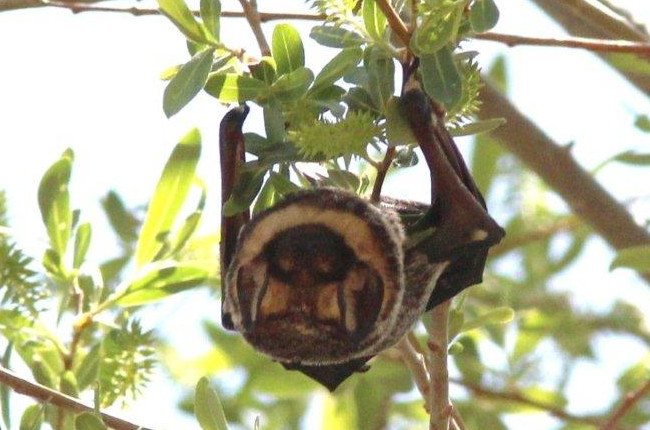
Have a wonderful summer, and enjoy just "hanging out" with the birds and wildlife!
Hoary Bat, photographed by Debby Parker
Back to Top




























